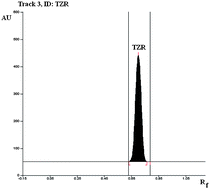HPTLC method for estimation of tazarotene in topical gel formulations and in vitro study
Abstract
A new, eco friendly, simple, and rapid high-performance thin-layer chromatographic method was developed and validated for quantitative determination of

* Corresponding authors
a
Indukaka Ipcowala College of Pharmacy, Sardar Patel University, New Vallabh Vidyanagar, India
E-mail:
mrunalipatel@gmail.com
Tel: +91-9824916565
b A. R. College of Pharmacy and G. H. Patel Institute of Pharmacy, Sardar Patel University, Vallabh Vidyanagar, India
A new, eco friendly, simple, and rapid high-performance thin-layer chromatographic method was developed and validated for quantitative determination of

 Please wait while we load your content...
Something went wrong. Try again?
Please wait while we load your content...
Something went wrong. Try again?
M. R. Patel, R. B. Patel, J. R. Parikh and B. G. Patel, Anal. Methods, 2010, 2, 275 DOI: 10.1039/B9AY00240E
To request permission to reproduce material from this article, please go to the Copyright Clearance Center request page.
If you are an author contributing to an RSC publication, you do not need to request permission provided correct acknowledgement is given.
If you are the author of this article, you do not need to request permission to reproduce figures and diagrams provided correct acknowledgement is given. If you want to reproduce the whole article in a third-party publication (excluding your thesis/dissertation for which permission is not required) please go to the Copyright Clearance Center request page.
Read more about how to correctly acknowledge RSC content.
 Fetching data from CrossRef.
Fetching data from CrossRef.
This may take some time to load.
Loading related content
